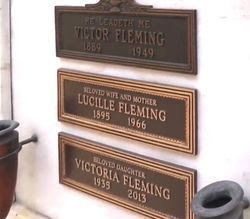1882-1967
Famous American operatic soprano, noted for her talent in dramatic performance, both on the stage and in film, Geraldine Farrar was born Alice Geraldine Farrar on this day in Melrose, Massachusetts. Her father was major league baseball player Sidney Farrar. She began studying music in Boston at the young age of just five and was giving public/professional recitals by her early teens. As an older teen, she studied voice in New York and Berlin, Germany. She also made her professional opera debut in Berlin in 1901 at the age of 19 in a performance of Gounod's Faust. She stayed employed there at the Berlin Hofoper under famous soprano Lilli Lehmann for three years, thereafter moving to the Monte Carlo opera in Monaco; finally making her New York operatic debut at The Met in 1906. She remained there until 1922, giving literally hundreds of performances. She enjoyed a local popularity unusual even for the times amongst young women, helped greatly along by recordings that she made for Victor, and only heightened by the fact that during the teens, she had a short film career. She made her film debut in 1915 in Cecil B. DeMille's Carmen, opposite Wallace Reid as Don José (the film does survive and is available on disc). I don't think it's going too far to say that the film made her a kind of movie star outside of the New York area among people who were unaware that she was first, and foremost, an opera singer. For such a busy opera star, she had a surprisingly prolific film career between 1915 and 1920, making more than a dozen films by the end of 1919; with all of her films through 1917 being directed by DeMille and a few of them quite famous. They include: Joan the Woman (1916), The Devil-Stone (1917) a rather famously partially lost DeMille film and The Woman God Forgot (1917) in which she plays an "Aztec" princess. Wallace Reid is the male lead in all of these films. Most of the rest of her film performances were directed by Reginald Barker, though she did appear in one film directed by Frank Lloyd: The World and its Woman (September 1919). That film had Farrar appearing opposite actor Lou Tellegen, to whom Farrar was also married at the time. Tellegen appeared in two more of her films in the later portion of her career: Flame of the Desert (1919) and The Woman and the Puppet (1920). The couple divorced in 1923 in a very public fashion (Tellegen would take his own life a decade later). Farrar's last film role came in The Riddle: Woman in 1920; the film starred Farrar opposite Montagu Love with Madge Bellamy and Adele Blood in supporting roles. Farrar retired from the opera just two years later in 1922 at the age of 40, switching to recitals and recording sessions for records. She also briefly worked in radio, but as an opera commentator, not a performer. Additionally, she penned an autobiography that was published in 1938; it was written in, shall we say, an "unconventional style" with part of the narration coming from the point of view of her deceased mother. Farrar never remarried or had any children, but always had a small dog to keep her company. Interestingly, her recorded music has not been used much for soundtracks; given that she recorded so much music, one would think that it would have been used more twice (the latest use of her voice came in the horror anthology film Scary Stories To Tell In The Dark). Unusual for an opera performer, never mind such a prolific star of the operatic stage, Farrar did take her film acting completely seriously. She was even willing to do promotion work for the films before and after release. As a result of this, a number of lengthy quotes from her remain even for lost films in which she acted. Farrar died of heart failure in Ridgefield, Connecticut on the 11th of March in 1967 at the age of 85. She is buried at the Kensico Cemetery which is located on Valhalla, New York in Westchester county.
 |
| [Source: Wikipedia] |










































